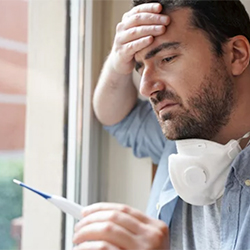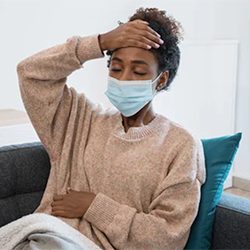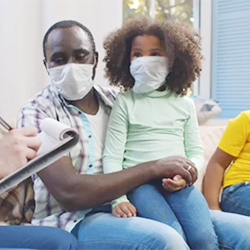By Marie Rosenthal, MS
Several studies this week looked at transmission. People with COVID-19 are most likely to spread the virus to close contacts right before and after symptoms appear. Another study found that the infection spreads quickly through households. A third study revealed that regardless of how one develops antibodies—either through natural infection or vaccination—the variants are pretty good at reducing the body’s defenses, and this study didn’t even look at the delta variant. Many infections probably went undocumented in 2020, and last, but not least, COVID-19 survivors report significantly higher symptoms of post-traumatic stress disorder.
Symptomatic COVID-19 Patients More Contagious
People with COVID-19 are most likely to spread the virus to close contacts two days before the onset of symptoms to three days after symptoms appear, and the risk for transmission is highest when patients have mild or moderately severe disease (JAMA Intern Med 2021 Aug 23. doi:10.1001/jamainternmed.2021.4686).
The findings support the need for continued interventions like contact tracing, masking and vaccines, according to lead author Yang Ge, a doctoral student at the University of Georgia (UGA) College of Public Health, in Athens.
“We found asymptomatic cases had lower transmissibility compared with symptomatic cases and were less likely to infect their contacts. In addition, we found that contacts that developed COVID-19 infections were more likely to be asymptomatic if they were exposed to an asymptomatic case,” Mr. Ge said.
The research team drew its findings from a large cohort study of 730 individuals who received a COVID-19 diagnosis in Zhejiang Province, China, between Jan. 8 and July 30, 2020.
Using detailed health records and contact tracing, the team applied state-of-the-art analytical approaches to determine how the timing of exposure and disease severity affected the risk for transmission.

The cohort included 8,852 close contacts, defined as household members, co-workers and those exposed in a health care setting, or shared transit.
These results need to be repeated in vaccinated populations. This large contact-tracing study identifies a high-risk transmission window to help local municipal and public health officials target contact tracing efforts, according to Ye Shen, PhD, an associate professor of epidemiology and biostatistics in public health at UGA.
“This suggests interventions like vaccines and masking should continue to be encouraged.”
Vaccines not only protect the vaccinated individual, but they also work to suppress the amount of virus that close contacts could be exposed to, and masking reduces the spread of aerosolized particles that could contain the virus.
—Lauren Baggett wrote the original story for the UGA website. Content was edited for style and length.
Natural Infection or Vaccine? Both See Reduced Defense Against Variants
Blood serum drawn from people previously vaccinated or naturally infected showed significantly reduced defense against two widely circulating variants of the novel coronavirus SARS-CoV-2 (Nat Commun 2021 Aug 26. doi:10.1038/s41467-021-25479-6).
Researchers said their findings emphasize the importance of vaccinations combined with maintaining public health measures to cut off the spread of the SARS-CoV-2 virus.
“We know that the virus continues to evolve for its own advantage,” said co-senior author Fikadu Tafesse, PhD, an assistant professor of molecular microbiology and immunology at the Oregon Health & Science University (OHSU) School of Medicine, in Portland.
Researchers found that the alpha variant (B.1.1.7) and beta variant (B.1.351)—two variants of concern—demonstrated reduced neutralization by antibodies in the serum of almost 100 people who were vaccinated with the Pfizer-BioNTech messenger RNA vaccine or previously infected by the virus. In the case of the beta variant, researchers measured a ninefold reduction in effectiveness compared with the original SARS-CoV-2 virus.
Even so, researchers took it as a positive development that vaccination and earlier infections still mustered some residual protection against the two variants of concern at the time. That finding appears to be consistent with a general reduction in the rate of hospitalizations and deaths worldwide, despite the increasing prevalence of the variants.
In contrast to other laboratory studies using non-replicative versions of the variants, the OHSU researchers used authentic virus variants isolated from patients and obtained from a national repository.
Scientists cultivated a cell line of the original SARS-CoV-2 virus along with the two variants in a Biosafety Level 3 laboratory on OHSU’s Marquam Hill campus. They pulled samples of each virus type, mixing each with blood samples collected from a total of 50 people in Oregon who received the Pfizer-BioNTech vaccine along with 44 who were previously infected with the coronavirus.
Researchers then measured the effectiveness of antibodies in blocking infection for each strain of the virus. The researchers found the reduction in antibodies was especially pronounced in people 50 years of age and older.
The heightened susceptibility of older adults is concerning, according to Bill Messer, MD, PhD, an assistant professor of molecular microbiology and immunology and medicine (infectious diseases) in the OHSU School of Medicine.
“The people who surround our older and more vulnerable populations need to get vaccinated and minimize exposure to the virus,” Dr. Messer said. “You can’t just walk into a nursing home because they’re all vaccinated. If you’re not vaccinated, that’s still a problem.”
Altered Neurons Associated With Long COVID Symptoms
COVID-19 survivors report significantly higher symptoms of post-traumatic stress disorder, and these symptoms are associated with changes to the brain’s connectivity (Neurobiol Stress 2021;15:100377).
Although COVID-19 is primarily considered a respiratory disease, experts recognize it also affects the nervous system, sometimes causing severe neurologic symptoms. Some COVID-19 survivors also experience long-term mental health problems, including anxiety, depression and PTSD.
Few studies have examined functional abnormalities in the brain, which might reveal the physiologic processes that underlie prolonged mental health symptoms in COVID-19 survivors.
The researchers sought to determine whether survivors experience functional disruption of large-scale brain networks, collections of discrete and widespread regions of the brain that work together to perform complex cognitive tasks. They collected functional MRI (fMRI) data and self-reported PTSD symptoms from 50 COVID-19 survivors, along with matched control subjects. The COVID-19 survivors were discharged between February and March 2020 from hospitals in Wuhan, China, and were tested about six months after their discharge.

The findings showed COVID-19 survivors self-reported significantly more symptoms of PTSD than the controls. The study also revealed COVID-19 survivors exhibited abnormal patterns of brain connectivity over time, which were significantly associated with greater PTSD symptoms.
The researchers identified three distinct, reoccurring states of functional connectivity in the patients’ brains. The COVID-19 survivors showed an increased occurrence of a particular state marked by patterns of connections between brain networks involving sensorimotor functions and visual networks.
“When we looked within the COVID-19 survivor group, we also found a significant relationship between the severity of their post-traumatic stress symptoms and how often their brain patterns are in that state,” said Vince Calhoun, PhD, a distinguished professor of psychology at Georgia State University, in Atlanta, and the director of the Center for Translational Research in Neuroimaging and Data Science.
COVID-19 Spreads Quickly Through Households
COVID-19 spreads quickly through a household, researchers from the University of North Carolina (UNC) said.
The observational study, conducted between April and October 2020, followed 100 patients who tested positive for COVID-19 around the Raleigh, N.C., area and included a total of 208 additional household members. A household member was defined as someone who was staying in the same living space as the person who tested positive. Researchers tested other household members with polymerase chain reaction nasal swabs weekly for three weeks following the initial SARS-CoV-2 infection, or by a seroconversion antibody test at the fourth week. Excluding 73 household members who already tested positive for COVID-19 when researchers got to their home, the secondary attack rate among household contacts was 32%.

“We think this number is actually much higher,” said Jessica Lin, MD, an assistant professor in the Department of Medicine, Division of Infectious Diseases, at UNC School of Medicine, in Chapel Hill, N.C.
“Sometimes we were getting to households to test people four or five days after the initial COVID-positive person showed symptoms. By that time, a lot of household members were already infected. But because that infection happened before we got there, we couldn’t include it in our data.”
This study also took place before the more infectious delta variant was widely circulating in the United States., leading Dr. Lin to believe the current secondary attack rate in households is significantly higher.
Most secondary cases occurred within the first week of the initial positive COVID-19 test. Researchers found that these secondary cases shared a similar nasopharyngeal viral load, or the amount of virus a person had in their nose and throat.
“This means the viral load of the index case matters,” Dr. Lin said. “A higher viral load means it’s more likely that there will be secondary transmission in a household, and viral load is also an indication of how sick a person could get from the virus.”
The study also looked at the concentration of people living within a household as a factor that determined whether COVID-19 spread to other household members. Of the participants enrolled in the study, 44% identified as Hispanic or non-white. Researchers found that minority households were more likely to experience a higher living density, and had a higher risk for secondary infection than white households.
“It’s very difficult to follow public health guidelines in some living situations,” Dr. Lin said. “If you have multiple people and generations sharing common areas or bedrooms, or say you are a single parent, it becomes nearly impossible to isolate or even physical distance.”
Dr. Lin said these findings all come back to one key message: vaccinations. The more people in a household who are vaccinated, the less likely the chance that secondary COVID-19 infections occur.
Even if one person is vaccinated, it helps, especially if the vaccinated person happens to be the first infection in a household. A person who has been vaccinated will most likely have a lower viral load, which will make it harder for the virus to infect other household members.
“Household transmission really is the main place where most people are getting COVID,” Dr. Lin said. “It’s spreading from their family and friends, people that are in their bubble and they feel safe with. When you get vaccinated, you aren’t just protecting yourself, you’re protecting those important people around you.”
{RELATED-HORIZONTAL}
